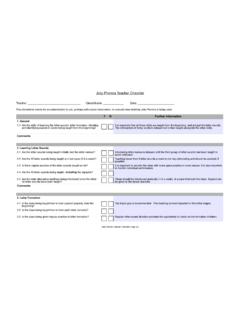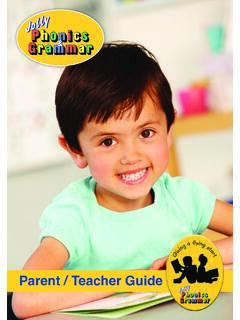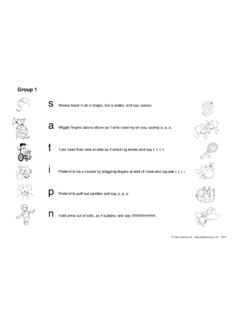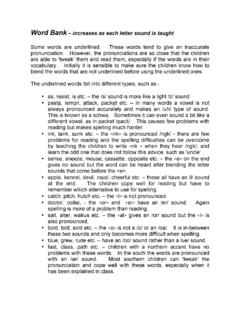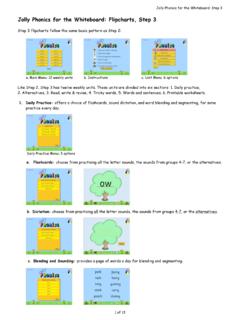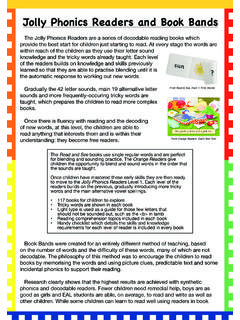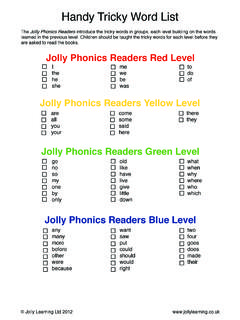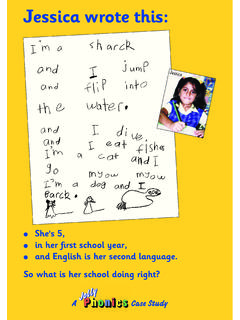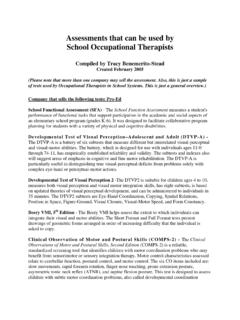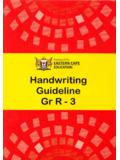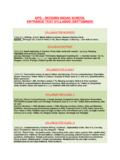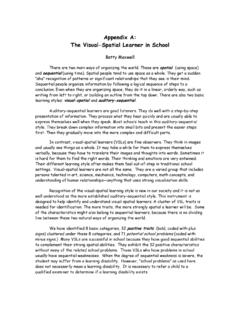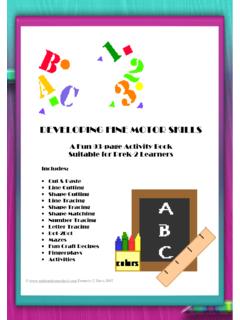Transcription of Jolly Phonics - Amazon Web Services
1 Jolly PhonicsJolly Phonicsis a synthetic Phonics scheme that teaches children the alphabetic codeof English. In the first nine weeks or so, the children are taught the 42 letter sounds,how to blend them to read words, and how to cope with the first few irregular this point the children can attempt to read books for are five main elements to the teaching:1. Learning the Letter SoundsThe main 42 sounds of English are taught one sound every day and in the s a t i p n2. c k e h r m d3. g o u l f b4. ai j oa ie ee or5.
2 Z w ng v oooo6. y x ch sh thth7. qu ou oi ue er arA multisensory method is used to introduce the children to the letter sounds. Thereis a storyline, action and Sound Sheet for each sound. By doing an action associatedwith the sound, , rub tummy and say mmmmm for the /m/ sound, the childrenremember it more child has their own Sound Book . Every day the letter sound taught is stuckinto the book and taken home. Parents are asked to help their children learn thesounds, either by going through the Sound Book, or by cutting up the letters andplaying a game of Pairs with their order to blend efficiently it is important to know the letter sounds fluently.
3 Everyday flash cards of the sounds that have been taught should be held up for the children to call out the sounds as they do the sounds, digraphs, are represented by two letters. The children need to recognizedigraphs in words, , the ng in strong . The digraphs oo and th each have twosounds, , book and moon , thin and that . In Jolly Phonicsthey are initiallywritten in two sizes to help the children understand that there are two Learning Letter FormationAs the letter sounds are introduced, the children are shown exactly how to form eachletter correctly.
4 Initially, the children form the letters in the air, at the same time asthe teacher. By regularly feeling the formation of each letter, and then writing it,most children should form their letters correctly after the first twelve weeks or so. It1is also important to teach the children to hold their pencil correctly, in the tripod letter formation in the Finger Phonicsbooks or tracing over dotted letters givesgood Jolly Phonicsmaterial uses the Sassoon Infant typeface with joining tails. Thismakes it easier for the children to transfer to joined-up (cursive) writing when thetime BlendingAs well as learning the sounds, the children need to be taught how to blend themtogether to hear a word.
5 This teaching starts on the first day. The aim is to enablethe children to hear the word when the teacher says the sounds, , Listen carefully,what word am I saying .. d-o-g ? A few children will hear dog . Try a few morewords, , s-u-n , b-oy , m-ou-se .Once the children can hear the word when an adult says the sounds, they are readyto try and blend words for themselves. Initially, being able to blend letter sounds fluently is the essential skill for reading and should always be the first strategy forworking out unknown words.
6 Children must also be able to recognize consonant blendsand digraphs in words such as fl-a-g and sh-o-p .After the letter sounds have been taught and the children can read simple, regularwords, they start taking home the Word Boxes for extra practice. The Word Boxesstart with simple words made from the first group of letter sounds. Invariably, thechildren who are the fastest at learning to blend sounds become the more fluent first, one way of spelling each vowel sound is taught, , ai as in rain . The children should have practice blending these spellings in words before the alternativesare introduced, , ay as in play and a-e as in lane.
7 Once the children have worked their way through the Word Boxes, and learned someirregular common keywords, they should be given storybooks to read for to parents that their child may not bring home a storybook until they havemastered the skill of blending. Parents should then encourage their children to talkabout what they have Identifying Sounds In WordsIt is essential that children can hear the individual sounds in words, especially forwriting. Initially, the children are asked to listen carefully and say if they can heara given sound in words.
8 Start with words that have three sounds in them, for example, Is there a s in sun .. mouse .. dog ? ; If there is a s where does it come thebeginning, middle or end? . Then the children are encouraged to say the sounds theyhear. Practice by saying a word like hat . The children should respond by saying h-a-t . As they say each sound they hold up a finger .. h-a-t three fingers, three2sounds; sh-i-p three fingers, three sounds, etc. Progress to more complicated wordssuch as those with initial and final consonant teacher writes the letters on the board as the children say them.
9 Then the childrenlook at the word, say the sounds and blend them to read the word. This gives a goodunderstanding of how reading and writing work. A few examples every day helps todevelop this soon as the children can hear the sounds in three letter words they can start theirdictation homework, material in The Phonics a child can hear the sounds in words, and knows one way of writing each sound,they can write independently. Initially, the children will not spell accurately buttheir work can be read, for example, I went hors riedin that wos fun.
10 Most children,by the end of their first year, should be able to write their own news and simple storiesindependently. It will be exactly what they want to say as they are not restrictedby writing only the words they have learned by heart. Accurate spelling developsgradually from reading books, knowing the alternative vowel sounds and following aspelling Tricky WordsAfter their first month at school, when the majority of the children know about 18letter sounds and have been blending regular words as a group activity, they canbegin to learn the tricky words.
